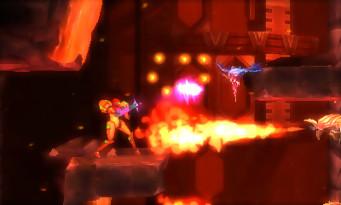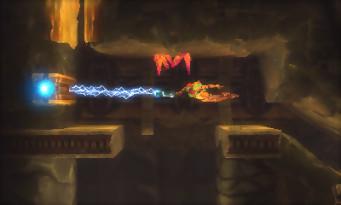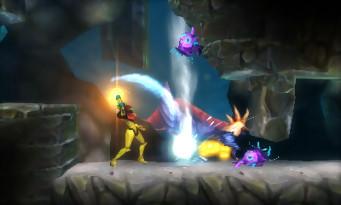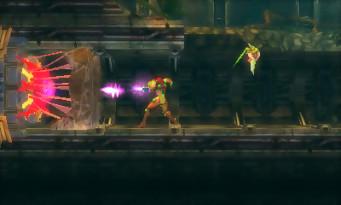 With a slightly modified name and which loses its Roman numeral, Metroid: Samus Returns nevertheless remains very close to the original Game Boy version, Nintendo having probably laid the groundwork for their collaboration with the creators of the Castlevania: Lords of Shadow series. If you are ever a novice, allow us to resituate the action for you. After battling the space pirates (the "real" villains of the series), Samus is sent to the planet SR388 which is home to the Metroids, jellyfish-like creatures with sacred powers, which have been used as a weapon by pirates. The idea is simple for the authorities: send soldiers to their planet, kill all the Metroids, and deprive the space pirates of their armament. However, after the failure of several military missions, the authorities decide to send the bounty hunter Samus Aran. From the first foot on this mineral asteroid, the player faces his primary objective: the genocide of the Metroids. There are 40 of them, which are scattered all over the planet, so you will have to explore in search of them, but also in order to get your hands on the many improvements that will give Samus new powers. In a fairly classic way, we therefore start the game with the jumps, and the possibility of using our radius. First novelty: where we had to fence to hit our targets on Game Boy, the developers have brought a touch of modernity with a free sight. By pressing the L button, you direct Samus's shooting angle to 360°, which allows you to hit any enemy, whether you are standing, crouching or even clinging to a ledge.
With a slightly modified name and which loses its Roman numeral, Metroid: Samus Returns nevertheless remains very close to the original Game Boy version, Nintendo having probably laid the groundwork for their collaboration with the creators of the Castlevania: Lords of Shadow series. If you are ever a novice, allow us to resituate the action for you. After battling the space pirates (the "real" villains of the series), Samus is sent to the planet SR388 which is home to the Metroids, jellyfish-like creatures with sacred powers, which have been used as a weapon by pirates. The idea is simple for the authorities: send soldiers to their planet, kill all the Metroids, and deprive the space pirates of their armament. However, after the failure of several military missions, the authorities decide to send the bounty hunter Samus Aran. From the first foot on this mineral asteroid, the player faces his primary objective: the genocide of the Metroids. There are 40 of them, which are scattered all over the planet, so you will have to explore in search of them, but also in order to get your hands on the many improvements that will give Samus new powers. In a fairly classic way, we therefore start the game with the jumps, and the possibility of using our radius. First novelty: where we had to fence to hit our targets on Game Boy, the developers have brought a touch of modernity with a free sight. By pressing the L button, you direct Samus's shooting angle to 360°, which allows you to hit any enemy, whether you are standing, crouching or even clinging to a ledge.
A GAME WHERE YOU SAMUS
 A welcome addition as the planet SR388 is teeming with diverse and varied enemies, each with their own pattern, attack and weak point. No question of taking them lightly, each enemy being incredibly deadly, which results in a game over after two or three hits received. To prevent this, the developers have added a whole new ability to Samus' arsenal: the ability to parry. With a press of X, the heroine can indeed deliver a violent downward blow which - if well placed with the perfect timing - can stop almost any attack, while putting the opponent groggy for a handful of seconds. Be careful, because as in the original episode, the planet is dotted with save points that you will have to visit to keep your data when you leave the game. Initially, each death brought you back to the last save point, but again, the developers have brought a touch of permissiveness to the gameplay by adding a good old respawn system. In case of death against a Metroid for example, we can start again just a stone's throw from the room. Convenient for newcomers and younger players, not really used to being faced with punishing games. In the same way, the areas to explore have become simpler, and above all more instinctive. Each zone generally has an upgrade, two Metroids and some improvements to find in order to increase the capacity of missiles and the size of the life gauge. The disadvantage is that the feeling of freedom is suddenly a little less great.
A welcome addition as the planet SR388 is teeming with diverse and varied enemies, each with their own pattern, attack and weak point. No question of taking them lightly, each enemy being incredibly deadly, which results in a game over after two or three hits received. To prevent this, the developers have added a whole new ability to Samus' arsenal: the ability to parry. With a press of X, the heroine can indeed deliver a violent downward blow which - if well placed with the perfect timing - can stop almost any attack, while putting the opponent groggy for a handful of seconds. Be careful, because as in the original episode, the planet is dotted with save points that you will have to visit to keep your data when you leave the game. Initially, each death brought you back to the last save point, but again, the developers have brought a touch of permissiveness to the gameplay by adding a good old respawn system. In case of death against a Metroid for example, we can start again just a stone's throw from the room. Convenient for newcomers and younger players, not really used to being faced with punishing games. In the same way, the areas to explore have become simpler, and above all more instinctive. Each zone generally has an upgrade, two Metroids and some improvements to find in order to increase the capacity of missiles and the size of the life gauge. The disadvantage is that the feeling of freedom is suddenly a little less great.
First novelty: where we had to fence to hit our targets on Game Boy, the developers have brought a touch of modernity with a free sight. By pressing the L button, you direct Samus's shooting angle to 360°, which allows you to hit any enemy, whether you are standing, crouching or even clinging to a ledge.
 In addition, we have a system that beeps when we are near a Metroid, which will allow us to orient ourselves quite easily. It should be added that Samus Aran also has new abilities that will help. Serving the new Aeon Gauge, four new powers will top off the bounty hunter's initial skills with a base shot buff, stasis that slows time, armor with a defensive force field, and finally a scanner that allows you to see at a glance where the destructible zones are. However, the range is quite generous, which is a bit detrimental to exploration, especially since this scanner is often the absolute weapon for finding the entry point of an unvisited room on the map. The latter is also permanently present on the lower screen of the 3DS so that we are never lost in the maze of the planet. The bottom screen is also used to choose the weapon you want to use (classic beam, freezer, grappling hook, etc.), but also to see what Aeon power is used (the selection is made via the cross ). By coupling all these weapons and powers to the equipment available in the original game (including the Spider Ball which allows you to climb the walls), we find ourselves with an impressive number of possibilities, which will force you to dig your brains in certain passages, and especially to manage the Aeon energy bar well. Indeed, some passages will call on the powers that depend on this bar, but the latter only recharges with certain orbs, or when you kill enemies.
In addition, we have a system that beeps when we are near a Metroid, which will allow us to orient ourselves quite easily. It should be added that Samus Aran also has new abilities that will help. Serving the new Aeon Gauge, four new powers will top off the bounty hunter's initial skills with a base shot buff, stasis that slows time, armor with a defensive force field, and finally a scanner that allows you to see at a glance where the destructible zones are. However, the range is quite generous, which is a bit detrimental to exploration, especially since this scanner is often the absolute weapon for finding the entry point of an unvisited room on the map. The latter is also permanently present on the lower screen of the 3DS so that we are never lost in the maze of the planet. The bottom screen is also used to choose the weapon you want to use (classic beam, freezer, grappling hook, etc.), but also to see what Aeon power is used (the selection is made via the cross ). By coupling all these weapons and powers to the equipment available in the original game (including the Spider Ball which allows you to climb the walls), we find ourselves with an impressive number of possibilities, which will force you to dig your brains in certain passages, and especially to manage the Aeon energy bar well. Indeed, some passages will call on the powers that depend on this bar, but the latter only recharges with certain orbs, or when you kill enemies.
As you surely know, the hard difficulty mode will only be available if you have the corresponding Amiibo.
 Unfortunately, Metroid Samus returns is not faultless, far from it. Technically, the game blows hot and cold all the time. If the graphics are honest for the 3DS, there are some rather disturbing slowdowns during passages where the number of enemies increases, even with a New 3DS. Likewise, it was possible for us to access certain rooms when it should have been impossible. Trapped, we were thus forced to restart the game several times. Another example: if the 3D (yes, some players still use it) is absolutely magnificent, and probably as beautiful as in Pilotwings Resort, it increases the framerate problems to the point that we even ended up completely crashing the console. Finally, the worst drawback is rather political. As you know, the "Hard" difficulty mode (called Fusion) will only be available if you have the corresponding amiibo. If we are ready to accept DLC when the content is up to par, it is really difficult to convince ourselves that we will have to buy a figurine to obtain an additional difficulty mode.
Unfortunately, Metroid Samus returns is not faultless, far from it. Technically, the game blows hot and cold all the time. If the graphics are honest for the 3DS, there are some rather disturbing slowdowns during passages where the number of enemies increases, even with a New 3DS. Likewise, it was possible for us to access certain rooms when it should have been impossible. Trapped, we were thus forced to restart the game several times. Another example: if the 3D (yes, some players still use it) is absolutely magnificent, and probably as beautiful as in Pilotwings Resort, it increases the framerate problems to the point that we even ended up completely crashing the console. Finally, the worst drawback is rather political. As you know, the "Hard" difficulty mode (called Fusion) will only be available if you have the corresponding amiibo. If we are ready to accept DLC when the content is up to par, it is really difficult to convince ourselves that we will have to buy a figurine to obtain an additional difficulty mode.


























